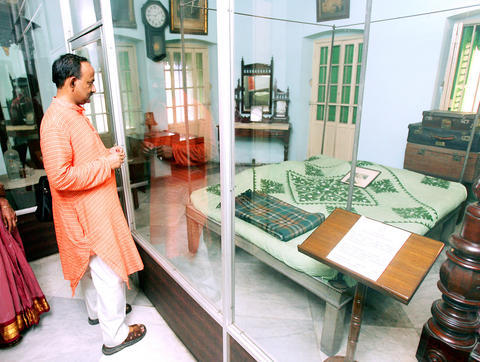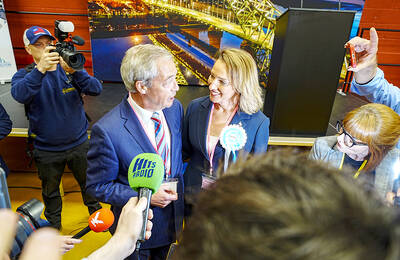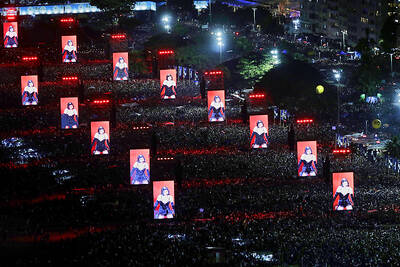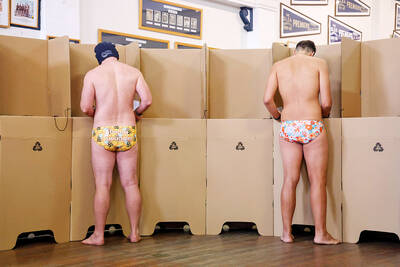Japanese Prime Minister Shinzo Abe yesterday voiced admiration for two controversial Indians who stood up to colonial ruler Britain during World War II and sided with Tokyo.
Abe visited the eastern city of Kolkata to meet relatives of nationalist Subhash Chandra Bose, who advocated violent resistance and backed imperial Japan, and Radhabinod Pal, the sole judge who dissented at the Allied tribunal that condemned to death wartime Japanese leaders.
"Many Japanese have been moved deeply by such persons of strong will and action of the independence of India like Subhash Chandra Bose," Abe said. "Even to this day, many Japanese revere Radhabinod Pal."

PHOTO: AFP
Abe, wrapping up a three-day official visit to India, has dismissed suggestions back home that meeting Pal's son would anger other Asian nations resentful over Japan's wartime actions.
In a dissenting opinion, Pal questioned the legitimacy of the tribunal, sealing a friendship between Pal and Abe's grandfather Nobusuke Kishi, who was charged but never tried as a war criminal.
Prashanto Pal, 81, told reporters he was "very, very happy to see" Abe.
"I feel proud of the fact that my father is still remembered for his contribution that was only correct and just. How can you blame only one side for war crimes and not the others?" he said.
Abe was speaking to reporters at the inauguration of the Indo-Japan Cultural Association in Kolkata and went on for talks with West Bengal state's Marxist chief minister Buddhadeb Bhattacharjee.
He was then to tour a museum dedicated to Bose, who broke with India's non-violence leader Mahatma Gandhi and won Japanese support for a military venture against British forces.
After World War II broke out, Bose escaped his British watchers, sought help from Nazi Germany and later went to Tokyo, where he organized an army.
"We're very excited, this is truly a historic moment," Krishna Bose, the nationalist's niece by marriage, said of Abe's visit.
The 76-year-old heads a trust that has preserved a three-storey residence in Kolkata as a museum to Bose.
"This is the first such visit and this makes it very special for us," she said. "It is a recognition of the role Bengal has played in building modern India-Japan relations."
Her brother-in-law Subrata, Bose's nephew, said the family was "deeply grateful" to Abe for this "unparalleled gesture."
The museum's walls are lined with black-and-white photos of Bose's parents, of him as a young boy, his May 1942 meeting with Adolf Hitler in Berlin and a picture of his German wife, Emilie Schenkl, holding their baby girl.
Other pictures capture his 90-day journey from Germany to Japan aboard a submarine between February and May 1943.
Another is allegedly the last known picture of Bose, in which he is seen stepping off a plane in Saigon on Aug. 17, 1945, a day before his widely disputed death in an aircrash in Taipei.
The exhibits include coats, caps and footwear as well as furniture and scores of books owned by Bose until he fled Kolkata in 1941.
"If Japan remembers Bose's support, we Indians have to remember that it was Japan which helped Bose assemble the Indian National Army" to fight British colonial rule, Krishna said. "Our future relations can be and will be enhanced when we remember the past that we share."
Abe's stop in Kolkata came at the end of a high-profile visit during which India and Japan vowed to seal an economic partnership deal by December.

Kehinde Sanni spends his days smoothing out dents and repainting scratched bumpers in a modest autobody shop in Lagos. He has never left Nigeria, yet he speaks glowingly of Burkina Faso military leader Ibrahim Traore. “Nigeria needs someone like Ibrahim Traore of Burkina Faso. He is doing well for his country,” Sanni said. His admiration is shaped by a steady stream of viral videos, memes and social media posts — many misleading or outright false — portraying Traore as a fearless reformer who defied Western powers and reclaimed his country’s dignity. The Burkinabe strongman swept into power following a coup in September 2022

‘FRAGMENTING’: British politics have for a long time been dominated by the Labor Party and the Tories, but polls suggest that Reform now poses a significant challenge Hard-right upstarts Reform UK snatched a parliamentary seat from British Prime Minister Keir Starmer’s Labor Party yesterday in local elections that dealt a blow to the UK’s two establishment parties. Reform, led by anti-immigrant firebrand Nigel Farage, won the by-election in Runcorn and Helsby in northwest England by just six votes, as it picked up gains in other localities, including one mayoralty. The group’s strong showing continues momentum it built up at last year’s general election and appears to confirm a trend that the UK is entering an era of multi-party politics. “For the movement, for the party it’s a very, very big

ENTERTAINMENT: Rio officials have a history of organizing massive concerts on Copacabana Beach, with Madonna’s show drawing about 1.6 million fans last year Lady Gaga on Saturday night gave a free concert in front of 2 million fans who poured onto Copacabana Beach in Rio de Janeiro for the biggest show of her career. “Tonight, we’re making history... Thank you for making history with me,” Lady Gaga told a screaming crowd. The Mother Monster, as she is known, started the show at about 10:10pm local time with her 2011 song Bloody Mary. Cries of joy rose from the tightly packed fans who sang and danced shoulder-to-shoulder on the vast stretch of sand. Concert organizers said 2.1 million people attended the show. Lady Gaga

SUPPORT: The Australian prime minister promised to back Kyiv against Russia’s invasion, saying: ‘That’s my government’s position. It was yesterday. It still is’ Left-leaning Australian Prime Minister Anthony Albanese yesterday basked in his landslide election win, promising a “disciplined, orderly” government to confront cost-of-living pain and tariff turmoil. People clapped as the 62-year-old and his fiancee, Jodie Haydon, who visited his old inner Sydney haunt, Cafe Italia, surrounded by a crowd of jostling photographers and journalists. Albanese’s Labor Party is on course to win at least 83 seats in the 150-member parliament, partial results showed. Opposition leader Peter Dutton’s conservative Liberal-National coalition had just 38 seats, and other parties 12. Another 17 seats were still in doubt. “We will be a disciplined, orderly